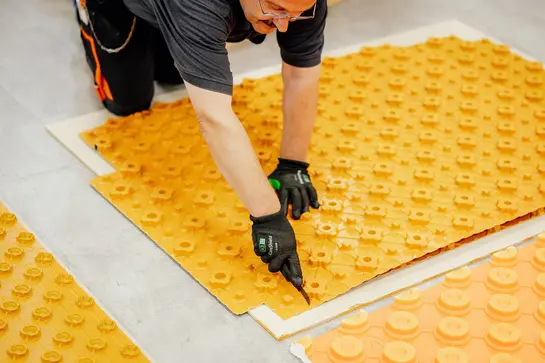The reliable Schlüter-BEKOTEC covering assembly technology is a system for functionally safe, floating screeds and heated screeds. This enables crack-free coverings made of ceramic, natural stone and other covering materials.
This system is based on the studded screed foil panel Schlüter-BEKOTEC-EN-23-F-PS, which is directly adhered on top of a load bearing substrate and/or over conventional heat insulation and sound insulation panels. The special pressure-sensitive adhesive on the underside of the studded panel achieves an excellent bond with the substrate.
The geometry of the BEKOTEC-EN-23-F-PS studded panel dictates a minimum screed layer thickness of 31 mm between and 8 mm above the studs. The stud spacing allows for clamping the heating pipes of the system, which have a diameter of 14 mm and 16 mm*, in a 75 mm grid to produce a heated screed. Since only a relatively small amount of screed has to be heated or cooled (with a coverage of 8 mm, approx. 57 kg/m² ≙ 28.5 l/m²), the floor heating system is easily adjustable and ideally suited for operation at low supply temperatures.
The curing stresses that occur in the screed due to shrinkage are absorbed by the studded pattern. Stresses resulting from contraction buckling do not, therefore, affect the entire area, and it is not necessary to install movement joints in the screed. Once the cement screed is ready to support weight, the Schlüter-DITRA uncoupling mat (alternatively, Schlüter-DITRA-DRAIN 4 or Schlüter-DITRA-HEAT) is installed (gypsum-based screed ≤ 2 CM %). The ceramic tiles or natural stone are then installed directly over this layer, using the thin-bed method. Movement joints in the covering layer have to be created with Schlüter-DILEX according to industry standards.
Covering materials that are not susceptible to cracking, such as parquet or carpeting, are installed directly over the screed as soon as it reaches the corresponding residual moisture level.

